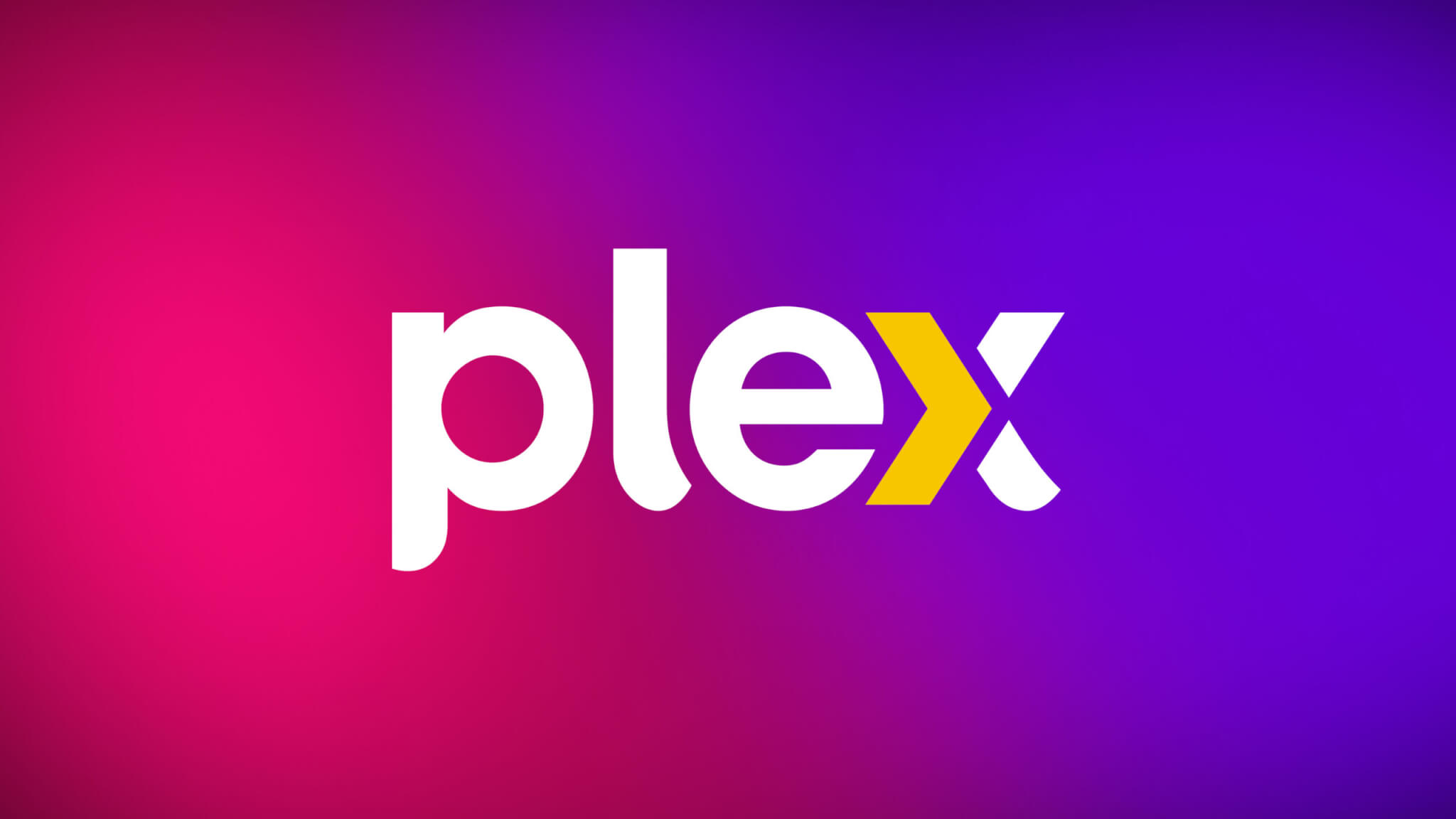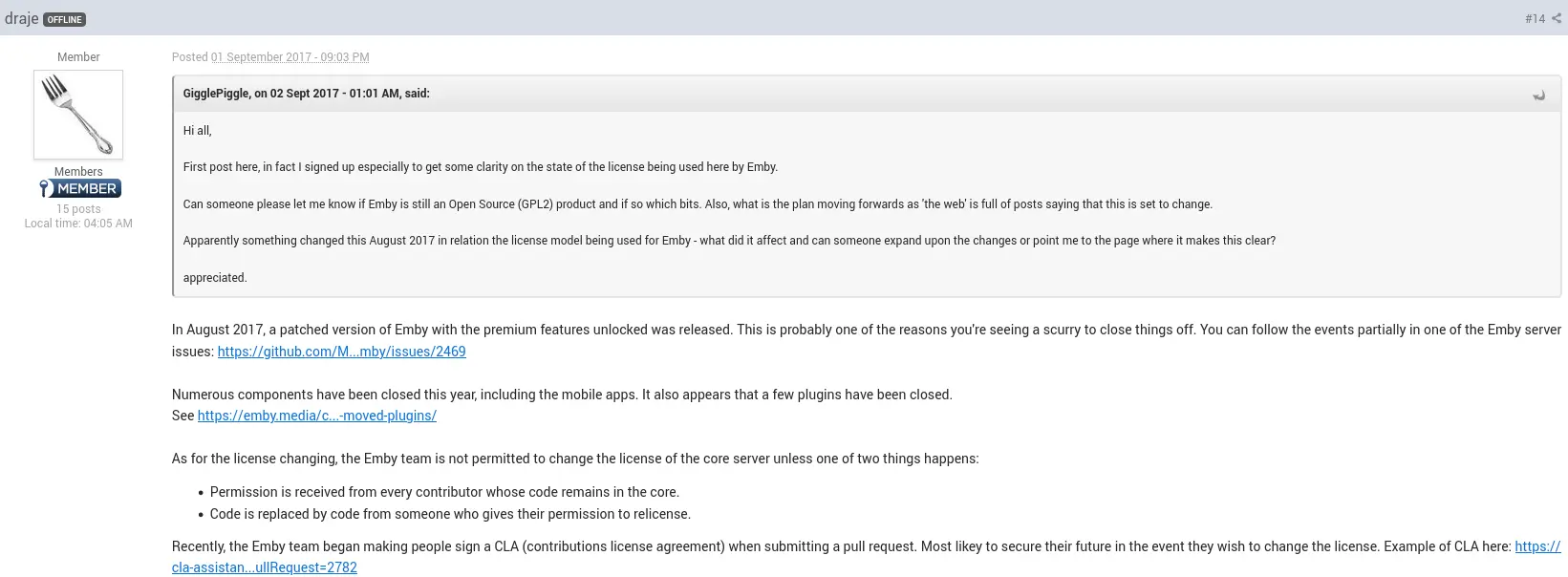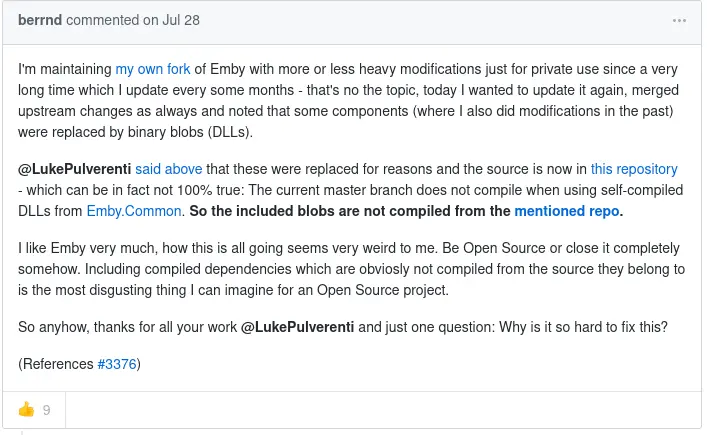We are also changing how remote playback works for streaming personal media (that is, playback when not on the same local network as the server). The reality is that we need more resources to continue putting forth the best personal media experience, and as a result, we will no longer offer remote playback as a free feature. This—alongside the new Plex Pass pricing—will help provide those resources. This change will apply to the future release of our new Plex experience for mobile and other platforms.
I’ve been using Plex many years. I abandoned it about 1-2 years ago when they began their enshittification journey. Now I see they are continuing to double down on being assholes.
They do not need any more resources to allow people to use what already exists. Most people run their own servers, and, they track all that by the way. Hence why people moved away from it.
Don’t give them your money. Let them rot. They fucked their user base who built them.
So glad i switched to jellyfin half a year ago
Same. My wife also just asked me to get a bunch of audio books too…so looks like I have to set up that now
https://arstechnica.com/gadgets/2025/03/i-threw-away-audibles-app-and-now-i-self-host-my-audiobooks/
Check out this arstechnica article on AudioBookshelf. Should cover most of what you need to get started.
The default Jellyfin client isn’t great for audiobooks.
For Apple iOS you might wanna look at https://github.com/LeoKlaus/plappa
For Android I would look at https://github.com/advplyr/audiobookshelf
Personally I just download the audiobooks from Jellyfin and play it in https://f-droid.org/packages/com.prangesoftwaresolutions.audioanchor/I run audiobookshelf and it’s amazing!
Thank you
I would recommend audiobookshelf for the audiobooks, especially if you have your stuff running in docker. It seemed to me like the solutions to force Plex or jellyfin to do books were a bit more hacky than I wanted.
“A subscription”
Its the same Plex pass subscription for people who don’t want to read a clickbait article.
As a result I imagine more users will look at other offerings such as Jellyfin.
https://github.com/jellyfin/jellyfin
https://jellyfin.org/This might be what it takes to at least get me to install it.
Do they live well together with the same shared media library?
Also, are there audiobook clients for Jellyfin?
I haven’t used Plex myself but Jellyfin doesn’t create any kind of meta files in the library folders. If that is true for Plex as well then I don’t see why it would be a problem to point them at the same shared library.
My experience is that both Plex and Jellyfin pointed at the same media files causes no issues.
Plex stores its metadata in a special folder, and I’ve got the *arr stack managing the actual media files, so I think I can run them in parallel.
Looks like I’ve got a project for the weekend! Jebediah’s just gonna have to wait to go to Jool.
Of you use docker plex and jellyfin arent gonna be messing with your media unless you delete/modify them within the respective clients (but then again thats what *arr is for)
I found audiobooks to be kind of awkward on jellyfin. I’m now running Audiobookshelf for all my audiobooks, radio shows and podcasts. Together with the Lissen app on Android, it works very nicely!
And what about just plain music? Is Jellyfin or Audiobookshelf better suited for that?
For music, I selfhost navidrome. Works nicely with the Tempo app on android, or Feishin on desktop.
My Jellyfin and Plex containers were able to use the same locations for media.
I’ve had Jellyfin and Plex running using the same media directory for a couple years now. I think I had to make a couple small changes for things like seasons of a TV show to show up correctly, but nothing incredibly difficult. Definitely worth setting up and playing with periodically so when you do finally get sick of Plex, you’re ready to just switch.
Only thing I use Plex for exclusively now is when I’m flying, Plex has the Netflix style download option and Jellyfin just downloads the video file. I like Plex’s way better just from personal preference.
I didn’t enjoy using Jellyfin for audiobooks, on my android I use the Jellyfin client to download the book I wanna listen to and then I use AudioAnchor for listening to it.
I’ve heard rumors that they do play well together, but that’s people running it in docker with a “read-only” flag set for the content folder, with metadata saved in the config folder
I’ve used the Jellyfin app to listen to audio books, but for my purposes, it’s easier to run the separate client/server Audiobookshelf.
Makes sense. I’m fully dockerized so I’ve got that going for me
FUCK Emby! What they did was worse than what Plex is doing even now
Another user said that was because users were modifying the code to avoid supporting the project? I got a lifetime subscription relatively inexpensive and haven’t had trouble
Who said that? I did a search in the thread and no Ody said anything about that that I saw
So the issue is kind of similar to bitwarden; how to protect the premium bits when having an open source core?
They just didn’t handle it as gracefully.
https://www.theregister.com/2024/11/04/bitwarden_gpls_password_manager/Here’s the history regarding emby if you’re curious:
https://github.com/nvllsvm/emby-unlocked
What did they do?
Basically, slammed the source code door shut after making promissory statements like “Don’t worry, we’ll always be open source” for years. With little/no notice they relicensed everything and pivoted to a closed source paywall model.
No discussion with the community or contributors, no alternatives explored, no polls or surveys. Just woke up one day to a “Sorry, but we’re going closed source because moneyyyy” blog post
Jellyfin was born right after, forked out of vengeance.
In retrospect we should have seen it coming when they would do odd little things, like keeping the build scripts closed source n crap, but eh hindsight and all that lol
They too put a whole lot behind their subscription though
https://emby.media/support/articles/Premiere-Feature-Matrix.htmlI bought a lifetime sub, now I don’t have to pay anything
What a load of BS.
The reality is that we need more resources to continue putting forth the best personal media experience
How stupid do they think we are?
Alright, so I have had Jellyfin installed for years now, but my primary issue is that most devices myself or my users use lack official, readily-available clients. For example, the Samsung TV app is a developer mode install. Last I looked, nobody has put a build into the store.
I really want to use Jellyfin, but I feel like my users simply can’t. I’m interested in others’ experiences here that could help.
A Chromecast TV device might fill your gap. There is a jellyfin android TV build in the app store and it works with every TV. Just costs about 50 dollarydoos
They even have Android app. I mean, a server app.
Anyway, they still seem to paywall some things.
Don’t ever connect a “smart” tv to the internet. It’s only going to become shit and steal your data.
Raspberry Pi, old pc or any kind of other external player will always be better for connectivity and control.
I agree, but having looked down this road, finding a quality external player that users will understand and is inexpensive is … not easy.
If you’re an Apple user the AppleTV is exactly this. It’s probably Apple’s most fairly priced computing device.
Facebook made one. They attached a gorgeous voice-controlled video-chat-on-tv setup to it, and released it just as they lost all consumer trust.
Then they decided it wasn’t selling.
So they killed it instead of open-sourcing it
just saying.
True, but there’s not much one can do about others’ stubbornness. I’ve been using cheap Android boxes with Kodi or the JF client installed. They make sense to my non-techie family. Dedicated boxes are better (something that can run CoreELEC, OpenELEC) but those are harder to find.
An old pc running Linux mint and kodi is my current setup in the living room.
While I agree with you 100% and every tv in my home is under this mantra I get where the parent comment is coming from. Family members and friends visiting have asked about access to my Jellyfin library and they aren’t necessarily keen on buying additional hardware, aren’t willing to educate themselves on setting up options that would be objectively better for connectivity, privacy, control, etc.
They just want an app in their TVs app store. It’s convenient and easy. I disagree with them but I don’t blame them. It’s human nature to go for the option that results in expending the least amount of effort. But then they don’t get my sweet Jellyfin library. If you cant run the client or kodi then I can’t help you, sorry.
I can speak from my experience with an Apple TV, the application “Infuse” works amazing with a jellyfin server. Though the application is essentially $1 month subscription, but works across all your apple devices, if you have any. I think it’s worth it.
Additionally, the official app for Android TV worked pretty well when I last tried it on an Nvidia Shield
I mean, except for Tizen OS isn’t most available? You can find the client for Android, Android TV, Windows, Linux (Flatpak), macos, apple ios, and more.
https://jellyfin.org/downloads/clients/I was just able to download it on every PC I have
Linux (Flatpak)
So, no, then.
Flatpaks aren’t the worst, at least it’s not a snap only
What do people have against flatpaks? I like them.
Part of it is that Ubuntu/Canonical so aggressively pushed Snaps which became a huge culture war. So you have people who hate the idea of those style of packages because they hate Snap AND people who hate flatpak because they are Team Ubuntu for some reason.
And the other aspect is that it is incredibly space inefficient (by the very nature of bundling in dependencies) and is prone to “weirdness” when it comes to file system permissions and the like. And many software projects kind of went all in on them because it provides a single(-ish) target to build for rather than having a debian and an arch and a redhad and a…
Ah, if you’re allergic to flatpaks and can’t convince your distribution to include it in their repository then you can always build it yourself - https://github.com/jellyfin/jellyfin-media-player
Or just use their web based client with a browser of your choice. :)No idea what Flatpak is, much? Jellyfin is open-source. If your distro isn’t providing you a .deb or tarball to your liking, that’s not on the Jellyfin project.
Why would you ever bother to use either option when you can just access it via the WebUI on Firefox?
Because that basically requires transcoding for modern codecs. H265? Transcode. Subtitles? Transcode. The JF client on the same hardware can usually direct play.
Oh fair enough, I’d highly recommend enabling transcoding anyway it just eliminates all sorts of issues like this.
Don’t ask me? I’ll ftp before I’ll WebUI like so, but for online viewing, I’ll take streaming please. My kids, wife, and mother-in-law find that a million times more convenient.
Meanwhile, there’s a dude in these comments hating on the notion that Jellyfin’s app will download the Raw file for offline viewing purposes. Please, do not ask me to pretend to care what is going on in that person’s head. In my world, using VLC to play my files is a perk. Gimme that yummy 2x or slow-mo as I see fit, please.
WebUI is streaming though on desktops though and I assume they’re also using iOS/Android/TV which all have clients, so I’m trying to get at the difference there.
I give all my friends the choice between Plex and jellyfin (I run both containers side by side pointed to the same media folders) and they all invariably choose Plex. I think it has a lot to do with the jellyfin UI, and I think an overhaul like jellyfin-vue or something that looks like findroid needs to happen in order for jellyfin to really appeal to regular people.
Yeah, I’ve written some custom css to get some better wrapping of libraries and such.
There’s also the community themes worth looking into.
https://jellyfin.org/docs/general/clients/css-customization/#community-themesDamn, all this time using JF and I never thought of theming it.
While I use it on a SFF PC I have a couple of users that access my server via a couple of CCwGTV Chromecasts I handed them and so, unable to test since I don’t have one to hand but can you / does it theme the UI on the Chromecast too?
Cheers!
I had the same experience with my parents. They have a Samsung TV and the Jellyfin experience was awful.
I ended up getting them a little N100 mini pc and installed Bazzite and the Jellyfin app from Flathub. You can configure it so it knows it’s on a TV, and responds to keyboard controls. I got them a remote from a company called Pepper Jobs that gives keyboard input and now they have a great experience with it. Even my mom, who’s a big technophobe, loves it.
My dad also has an LG TV in his workshop that doesn’t have a working Jellyfin app (cause it’s ten years old), and he uses the Jellyfin app for his Xbox on that one.
So the flatpak version of Jellyfin works for you? I cant get it to play more then one thing. hitting the play button just does nothing.
Just played a bunch of episodes on Fedora KDE (Flatpak from flathub, Jellyfin client v.1.11.1, Jellyfin server v.10.10.6) without any trouble.
Are you by chance using Wayland?
yep!
Figured it out. The flatpak version will fail to play video if you have audio pass through enabled. The .deb package works though.
I’ve never had an issue with the apps. It’s on my Chromecast and my android phone, and I typically stream to the TV from my phone.
My only issue is that they require a real cert (which is good tbh) and I am having trouble getting letsencrypt working due to my isp blocking port 80 and me dragging my feet getting DNS working
I love Jellyfin, but I always find something that I have a problem with when trying it, for example it has weak searching, tagging, and TV show identification compared to Plex.
I tried using it even as recent as yesterday for some searching and tagging, but it’s searching, tagging, and even TV show identification has problems and is weak in comparison to Plex. I couldn’t mass-tag certain videos which was annoying for me, I had to do it one-by-one and it ended up taking a long time, that was frustrating. Also, tags don’t show up in searches anymore because it hurts performance apparently. With that said, maybe Plex has the same limitation, but it doesn’t mean that Jellyfin has to. They are open-source, and they can be better than Plex, and in many ways they already are, but I keep running into pain points with how I want to use it, and it does feel a bit unfortunate. With that said, I’m a developer too, so I know it’s not always that simple. It’s just in some ways it feels less “complete” than Plex.
I’m still really pleased with Jellyfin though, and especially the future potential of it.
You can access Jellyfin through a browser, too. Is that an option for the Samsung TV?
I run an Android TV box on my Smart TV, because I don’t trust them on the internet.
I use Jellyfin client on my new Samsung TV via a Google TV dongle (ONN tv, $25 at Walmart). Seems to work well.
My only complaint is the stream volume has been very low after a recent update. Downsampling helps but seems like it shouldn’ t be necessary.
Yeah.
Jellyfin is spectacular for LAN usage on two computers. Once you start using devices (because, you know, that is what people tend to plug into their TVs…) or going on travel, it rapidly becomes apparent that it just isn’t a competitor.
Hell, a quick google suggests jellyfin STILL doesn’t have caching of media for offline viewing. Plex’s works maybe 40% of the time but… 40% is still higher than 0%.
I have a lifetime pass for Plex and encourage anyone who even kind of cares to get one next time it is on sale (or shortly before the scheduled price hike). I have tried Jellyfin a few times over the years and… it is basically exactly what I hate with FOSS “alternatives”. It isn’t an alternative in the slightest but people insist on talking it up because they want it to be and that just makes people less willing to try genuinely good alternatives.
To put it bluntly, Plex is an “offline netflix” as it were. Jellyfin is a much better version of smbstation and all the other stuff we used to stream porn to our playstations back in the day.
Huh? I used jellyfin just fine in the hospital on public WiFi on my ancient busted iPad air [some number].
The only thing I did was install pivpn and upload my VPN profile file to Google drive so I can remote into my network. I legit never even had to set anything up it just worked, didn’t even need to know the IP of the server because my locally run DNS server (and failing that, the basic hostname based DNSMasq in the router) took care of everything.
I don’t even have any reverse proxy or firewall because I still pretend to value my sanity and my time, nor did I expose it to the internet either, thanks to almighty NAT.
Didn’t have to do any caching or anything crazy like that, no idea what you’re talking about, but I think there’s an option to download the files right through jellyfin.
I watched star trek TAS while having fun with opioids and it was a great time.
That’s nice.
That doesn’t work if you are on an airplane (unless you want to spend the entire flight downloading one episode). Or if you just don’t want to deal with hotel wifi. Or if you just don’t want to expose your internal home network at all.
Which is the point and why this is one of those big features of plex that there are so many tickets and requests to get into jellyfin et al. Because yes, you can just copy files from your NAS to your phone’s internal storage (assuming you don’t care about transcoding and the like)… at which point there isn’t much use to a metadata oriented media server/service.
Or you can just set up Plex to always download the next 10 episodes of whatever show you are watching when it has network access. I mean… that probably won’t work (see: 40%) but when it does, it is awesome. Which is the “it just works” functionality.
Which gets back to the issue where, because it is FOSS, it is the greatest thing ever and anyone asking for anything else is wrong and stupid. Which is a shame because if the Jellyfin devs could actually get the “download the next N episodes” functionality to reliably work (even at 80-90%) it would be a killer app. And, for what it is worth, I have liked the devs a lot when I interacted with them in the past. But the users and evangelists are just… what we can see in this thread.
You can just download the episodes though? Like right in Jellyfin:

Because yes, you can just copy files from your NAS to your phone’s internal storage (assuming you don’t care about transcoding and the like)… at which point there isn’t much use to a metadata oriented media server/service.
No you do not need to do any of that.
Or you can just set up Plex to always download the next 10 episodes of whatever show you are watching when it has network access. I mean… that probably won’t work (see: 40%) but when it does, it is awesome. Which is the “it just works” functionality.
You can download in Jellyfin also, like in the screenshot above.
anyone asking for anything else is wrong and stupid.
I mean, you are asking for things that are already in the app, you tell me if that’s stupid or not. I’m just trying to help.
I’d never call anyone even trying to use these self-hosted alternatives stupid.
Jellyfin devs could actually get the “download the next N episodes” functionality to reliably work (even at 80-90%) it would be a killer app
Is there some reason you can’t do this manually? I actually can’t think of any app with this feature, not even Netflix way back not Spotify.
Jellyfin allows you to download whatever you want to your local device. But in a world of streaming, it seems to be a much smaller usecase. I take my tablet camping with me all the time, download some shows via Jellyfin and watch via Jellyfin. Maybe you’re using the term “caching” differently from the use case, but if local files is what you’re after, it absolutely does it. Just click download in a couple of different locations.
Did they? Or is that still the old hack of “just download the raw file. Your tablet is just a computer”?
Because I didn’t see it advertised on the main web page and a quick google got me to https://github.com/jellyfin/Swiftfin/discussions/364 which is open and abandoned tickets for the ios apps.
https://forum.jellyfin.org/t-offline-downloads?pid=16373#pid16373 suggests it is also in the same boat for android. You can find workarounds but they aren’t using jellyfin.
Which is “fine”. I watched WAY too many movies over the years with VLC on a laptop. But… why are we using a shim to treat a library as a streaming service in that case? Which gets back to Jellyfin just not actually being a Plex alternative for the majority of users.
You might be right, it might play in an external player. I don’t recall that or didn’t notice. We’re a few months from the last camping season. If it does play in an external player, seems like an inconvenience vs a dealbreaker, but I get it. We all have our things. I would argue that it’s maybe a big deal for you and not a majority of users. Maybe a small but focused minority.
Oh no! Please GOD, anything but tHe rAw fIlE!!
Seriously though, wtf did I just read? That can’t possibly be your real stance, can it?
Half of my collection is DTS HD MA or TrueHD and many have HDR. Offline caching with transcoding is an essential feature if we want jellyfin to pull ahead. Berating people who are pointing out areas of improvement is not a winning strategy.
I run ffmpeg on my phone. Alternately, I could shrink the file on my server and then download it without much trouble. You’re in a vanishingly small subset of users who know enough to care about file-size and know what can be done about it, but can’t be bothered to do it themselves.
This is a huge problem. The blueray remux might be 80 gigs. Most children’s devices will already be filled with other crap.
I run ffmpeg on my phone. Alternately, I could shrink the file on my server and then download it without much trouble. You’re in a vanishingly small subset of users who know enough to care about file-size and know what can be done about it, but can’t be bothered to do it themselves.
I was avoiding suggesting getting more storage, but it sounds like in your case, keeping a 720p x265 version of each file(~1gb per movie) on-hand would cost you nothing.
Your kids will be ok without the 4K60 version of Paw Patrol.
As I was curious, Findroid gives you an android client that allows offline mode and downloading/playing/removing movies from the client.
Seems Infuse Pro (paid) version also has support for it if you’re an iPhone user.
edit: I see the discussion regarding filesizes and I believe that Findroid is downloading the raw file in the background, so for those that wish for smaller transcoded versions in the cache it isn’t a solution. I don’t own any apple devices so can’t tell how Infuse handles it.
Yeah, I don’t know what that dude’s on about. My kids download stuff from jellyfin to their tablets all the time for road trips.
any recommendations to get it to work remotely? the good thing about plex was it was easy to set up, but the quality was medicore.
I just figured it out. You have to open the port on your router
I used a Cloudflare tunnel for security (no open ports) but that’s for people with limited tech ability mostly. Everyone else I’ve got connected with a tailscale node.
Yeah don’t use a cloudflare tunnel for that, it’ll get you banned.
I’m in the process of moving houses at the moment. But I’ve already got a nice PC put together to host a mess of services. Should be “fun” LOL
Careful with that I think it’s against their TOS to do that due to the large volumes of data video streaming takes.
Before now I was on the sunk cost fallacy of not wanting to teach my extended family how to use Jellyfin instead of plex but after this I’m already mid-way through setting up a Jellyfin docker container on my server and I only found out an hour ago
Jellyfin depends on proprietary Microsoft .NET, even on Linux.
It’s still better than Plex and Emby, which are fully proprietary, and have no source code. But I will stick with sshfs with kodi, and nginx plus mpv for now.
Except, it isn’t, .NET Core is an open source framework by the .NET Foundation
Alas my TV (LG WebOS 2) doesn’t have an application for Jellyfin, or I’d have switched years ago :-(
Is there an emby app available or Kodi? The base of Jellyfin should work in either. Plug and play as far as I’m aware with maybe some issues for certain versions.
I’ve been testing out jellyfin for the last couple months but it doesn’t really fill the void of this specific feature that’s being locked behind a pay wall. If anyone has good recommendations for securely and reliably hosting jellyfin behind SSL and auth with email password resets where I don’t have to worry about it as much as Plex.
I use jellyfin locally but for a handful of remote clients I have I may well block off their access they’re not going to be able to figure out my hand spun services and wall of text.
Authentik + jellyfin SSO plugin?
I haven’t tried it out personally, but I use authentik, for that you can just create a password policy, then add a new stage for identification (just make sure to add the email field), and an email stage, then create a flow.
More work on your end than paying someone else obviously.
I would go for a reverse proxy to get ssl running.
https://jellyfin.org/docs/general/networking/#running-jellyfin-behind-a-reverse-proxyHandling users with forgotten passwords is, sadly, a manual chore for the administrator.
https://jellyfin.org/docs/general/server/users/adding-managing-users#profileForget the Auth, use VPN profiles as access controls. Give them to trusted folks and you’re gold.
Dumb question but should there be VPNs operating on both ends, server and client? Or just the client because I’m guessing the server might change the connection address.
A VPN Server on the server or home network (look into PiVPN for instance), and a VPN Client on clients (look at openvpn for instance).
Good luck and let me know if you have any further questions - I’m more than happy to answer!
If this is enough to push you away from Plex but you’ve tried Jellyfin and it didn’t quite do it for you, try https://emby.media/
It is the software Jellyfin is forked from and bridges the gap between the freedom of Jellyfin and the polished look and function of Plex.
Absolutely not, fuck Emby with a branding iron, they’re far shittier than Plex’s decisions.
At least Plex started out as a for-profit company and has never misrepresented themselves as anything but. Unlike Emby.
Nah, as far as I’m aware Emby hasn’t started their own streaming service and pivoted away from their self-hosted oriented position, or shoving a bunch of bloat into their server software. They haven’t shoehorned a bunch of unwanted social features into it either. If you were fine paying for Plex five years ago, you’ll be fine with Emby.
Yea because like I said, they’re on an enshittification train on the same track just some stops behind, except they started with far worse decisions
It sounds like they haven’t even made their first stop, nor do they even have the train yet. And it seems like none of those bad decisions have even been made yet.
I guess you could predict that one day they will start their enshittification journey, but that day is not today.
How is the general perception of emby? They’re closed source and US based.
Emby remains in the position Plex used to, pre-enshittification. They’re closed source and have a PlexPass style license, but if you miss the value you got with old-Plex, Emby fills that spot.
For context, Emby used to be open sourced but offered the Emby Premiere subscription for some added features, and the open source half allowed people to just bypass the paywall, so they closed sourced it. Jellyfin is a Fork of Emby pre-closed sourcing.
Emby used to be open sourced but offered the Emby Premiere subscription for some added features, and the open source half allowed people to just bypass the paywall, so they closed sourced it. Jellyfin is a Fork of Emby pre-closed sourcing.
You should not be recommending them at all for any reason for that. I was there and saw the shit that went down over it.
Emby should be considered a no-go for all purposes.
Oh no I’d absolutely recommend it for anybody switching from Plex. Anybody who liked Plex and the state it was in pre-enshittification will obviously have no qualms with a proprietary solution. If FOSS is your end goal then you’d have a better argument, but Plex refugees are for obvious reasons not a part of that demographic.
Emby is a great product that “Just works” in the same way Plex used to and for that purpose it is head and shoulders above Jellyfin even if it doesn’t have the benefit of being FOSS.
That’s just putting them on another enshitification train that just happens to be a couple stops back, but is still moving along.
How they went about going closed source was unforgivable and also means they will absolutely have no qualms implementing crappy enshitification type decisions in the future
Emby’s enshittification train isn’t a couple stops back, there’s currently no evidence it exists. Simply having an Emby Premiere license is not enshittification for the same reason it wasn’t for Plex. Even in Plex’s most beloved golden age they had the PlexPass. That is not now nor was it ever an issue. Not every software existence has to be FOSS to provide any value. Emby went closed source and Jellyfin got to pick up the torch from that point on. That is a perfectly reasonable resolution as thats how things are supposed to work, that’s a good thing. Do you see Plex being forked into an open source version? No you don’t.
I went from Emby to Jellyfin as they started their enshittification journey. I don’t really notice it being less polished.
I’m not aware of any enshittification with Emby, unless you know something I don’t. Emby sort of “just works” which is why it’s a more direct replacement to Plex than Jellyfin is.
As for Jellyfin, I check in on it every now and then and they’ve made a lot of progress but the features and polish aren’t there. I hear good things about the Jellyfin web component, butif you want a good experience with Jellyfin apps on mobile or whatever TVOS you’re running, you have to use third party apps because the official ones are still woefully barebones. I still hear a lot of griping about issues with subtitles, and HEVC playback.
Did Jellyfin ever even figure out proper Intro Skip? That was a big pain point for me for the longest time, as the only way to accomplish it was a third party plugin and the only option was to skip all intros, you didn’t get a button. I remember reading somewhere they added some kind of framework that would allow proper intro skipping going forward, but that the official function was not ready.
The media segments feature has been released as of 10.10.0 and it still needs a plugin. Still feels a bit clunky but works already on my Android TV box. I guess there will be more polish in future versions, now that the groundwork is done.
Yeah I heard about that. That is good news as it means hopefully Jellyfin can start closing the gap on feature parity with Emby.
The thing about people leaving Plex is that things being “clunky” is a nonstarter. The value of Plex was how everything just worked. You could give a link and credentials to your boomer mom and she’d be good to go. That’s why I still recommend Emby to these people as it’s still the best way to achieve that without paying for Plex. Here’s to hoping Jellyfin can reach that point soon.
Do you know how to get intro skipping to work? I’ve reinstalled the latest version of Jellyfin for testing and have the Media Segments Provider plugin installed, but there still seems to be no intro skipping button on any clients. People in this thread keep telling me it exists but outside of this thread there appears to be no evidence it exists.
It’s been a while since that I set this up, so take this with a grain of salt. I have these two plugins installed:
- Chapter Segments Provider
- The older Intro Skipper
I’m honestly not sure if I even need both - maybe the Chapter Segments Provider is unnecessary, even though it’s official and newer. I don’t understand exactly how it works from the docs.
However, Intro Skipper gives you a new scheduled task named “Detect and Analyze Media Segments”. Use this to extract metadata about media segments from your library.
Now that the server knows about some media segments you need a client that can handle them. I’ve had success with the Android TV App (check the settings) and the Web interface should support them too.
I didn’t need to configure anything aside from that, as far as I can remember.
With version 10.10 they integrated chapter markers into Jellyfin. You still need a plugin to generate the intro timings, but any client I tried has support for skipping with a button.
Well that’s good news, that means they’re close at least.
Subscriptions are a non-starter for me
I’ve paid for the lifetime subscription for Plex…Still only using Jellyfin
I can justify a one time purchase, but never recurring payments.
If it costs them money to run it, it makes sense?
deleted by creator
Why are they proxying the stream through their server though
How else would it work?
When I stream from my plex server it’s a direct connection between my device and the server. The only time it proxies through plex is if your server isn’t directly accessible, like ports are blocked or not forwarded properly.
Port forwarding, tailscale…
… Nebula…
Directly to the clients from the already self-hosted server, exactly like all the other media hosting software does. Lmao.
They typically don’t. They do proxy it if there is something preventing a direct connection, but the proxy bandwidth is super limited and results in pretty terrible playback quality.
deleted by creator
Not necessarily. Tailscale uses their own servers in order to do the negotiation, but once the connections are opened on both ends you should be directly connected to each other. All without port forwarding or any config on your end.
Right, but IIRC anyone can go on the plex.tv website and use shared servers due to the “proxy”
Plex borking itself a year ago for me is the best thing that could’ve happened. Long live jellyfin
I have a lifetime plex pass so this does not really affect me but I expect the trend of degrading experience to continue. I would have switched to Jellyfin a long time ago but I am dreading contacting everyone I share with and getting them migrated.
Same boat here. I chose Plex because the apps were everywhere. Smart TV’s, phones, web…
I can switch, no problem. I don’t want to have to teach my parents a new app. OMFG!
This is also true of Jellyfin, though. I have apps on my Windows PC, my Android phone, multiple Nvidia Shield boxes on my TVs, plus the web interface if I need it.
I switched over from Plex several years ago, and while it takes a bit more time to configure, compatibility for clients seems just as good for Jellyfin as it is for Plex.
Most importantly, Jellyfin is strictly client/server, no “cloud” bullshit and no remote account is required; I don’t want Plex phoning home with a list of the media on my file server.
Jellyfin certainly took off. Great for them. It just wasn’t polished or an option when I set things up way back then.
its actually the sole reason why i ended up paying for plex myself. its not because on ME that i ended up using plex, its moreso everyone else that I want to give my server access to with the least amount of hurdles that made me ultimately go that route.
I feel like it’s just a matter of time, until they pull the rug from under lifetime subs.
But in any case, this is probably it for me. I’m not completely happy with jellyfin performance on my server, but the price hike puts me outside of what i’m willing to spend for this service. I already host it myself, and i can tunnel it myself too, if i ever decide to run it outside of my home network
I can understand new features being behind a fee, but this is putting old, old capabilities behind a paywall. Hmmm…
This with a recent decision to remove watch together sort of eliminates the whole reason I would have tried Plex so many years ago.
I’m a fan of Plex (it’s worked for me) and understand the Jellyfin crowd too. I’m worried about who is calling the shots at the moment. They aren’t aligning with their users.
Old capabilities that don’t even work as well as free alternatives because AMD transcoding support has been “”“experimental”“” for years.
It looks like as long as the host has a Plex pass, this doesn’t change much. It is a regression of service, which sucks, but there are viable alternatives for those unable or unwilling to pay. And honestly, jellyfin is the clear winner in that case and always has been.
Now, if they start to charge my friends and family for access to my media after I have already paid them for their lifetime subscription, then I’ll grab a pitchfork with the crowd.
Also, why not run both and be ready? The resources required are minimal if you’re running via docker, just some extra RAM and a negligible amount of compute for overhead on library maintenance tasks.
Same. I’m not switching to Jellyfin yet either - mostly because of my boomer parents - but this is getting close to the tipping point for me
I run both on my unraid NAS. I use plex for streaming to my phone over cell data. I use jellyfin for streaming to my laptops and TV.
Plex tends to break every once and a while though. Not often, but it happens enough that I’m replacing it with just having my music on a DAP that is synced with Syncthing.
I also use the comic viewer function of jellyfin.


























